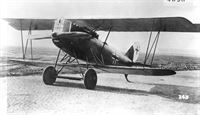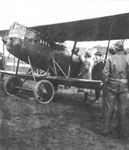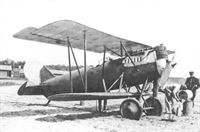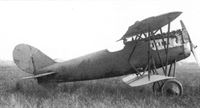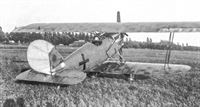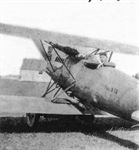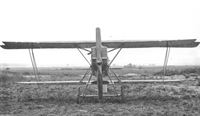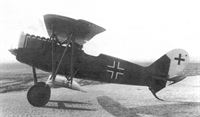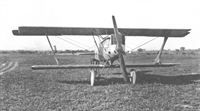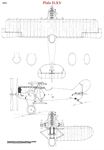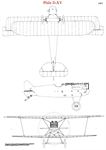
Описание
Страна: Германия
Год: 1918
Fighter
Варианты
- Pfalz - D.XIV - 1918 - Германия
- Pfalz - D.XV - 1918 - Германия
- O.Thetford, P.Gray German Aircraft of the First World War (Putnam)
- W.Green, G.Swanborough The Complete Book of Fighters
- J.Herris Pfalz Aircraft of WWI (A Centennial Perspective on Great War Airplanes 5)
- M.Dusing German Aviation Industry in WWI. Volume 2 (A Centennial Perspective on Great War Airplanes 85)
- P.Grosz, G.Haddow, P.Shiemer Austro-Hungarian Army Aircraft of World War One (Flying Machines)
-
J.Herris - Development of German Warplanes in WWI /Centennial Perspective/ (1)
Production Pfalz D.XV in factory finish. The D.XV was at the flugparks the last week of the war but did not reach combat. For the D.XV Pfalz had worked hard to eliminate the bracing wires of the D.XII for improved speed and climb and reduced maintenance. The D.XV accomplished those goals and was considered the equal in performance, maneuverability, and flying characteristics of the famous D.VII, but never had the opportunity to prove itself. It was forgotten and after the war Pfalz went bankrupt. Power was the 185 hp BMW.IIIa engine.
-
J.Herris - Pfalz Aircraft of WWI /Centennial Perspective/ (5)
Pfalz D.XVf 8364/17, which took part in the Third Fighter Competition in October 1918, was obviously camouflaged in the same manner as many of the production D.XII machines. It is conjecturally illustrated in the 'Canberra' pattern of D.XII colors. These sprayed colors were wrapped entirely around the fuselage. The cabane struts appear to have been a dark color, the rest a light silver-gray or blue. The wings and tailplane were in five-color fabric.
-
J.Herris - Pfalz Aircraft of WWI /Centennial Perspective/ (5)
Pfalz D.XV originally owned by Ernst Udet shown in the markings of its second owner, Max Holtzem, while barnstorming in Argentina. The aircraft was red overall with white lettering and the rudder was in the blue/white/blue Argentine national colors.
-
J.Herris - Pfalz Aircraft of WWI /Centennial Perspective/ (5)
A production Pfalz D.XV at Adlershof during type-testing. Production D.XVs had the 185 hp BMW D.IIIa engine, which used a pointed propeller spinner as seen here. There is no interplane bracing, which eliminated significant drag, and the ailerons have horn balances.
The Pfalz D.XV, finally with the 185 hp BMW.IIIa engine the Pfalz D.XII had needed to reach its full potential, was an excellent fighter developed from the D.XII. It was as fast and maneuverable as the Fokker D.VII, and the first examples arrived at the Army Flugparks the last week of the war. Just missing combat, it was forgotten in the aftermath, as was the Pfalz company, which went bankrupt soon after the war ended. -
J.Herris - Pfalz Aircraft of WWI /Centennial Perspective/ (5)
Pfalz D.XV given to Ernst Udet by Pfalz in 1919. Together with his friend Robert Ritter von Greim, like Udet a fighter ace and recipient of the Pour Le Merite, they obtained some Fokker D.VIIs and D.VIIIs from a factory in Bamberg. Udet had his three aircraft painted bright red, and the two put on a series of flying displays and mock combats in Bavaria. Later they acquired some Rumpler D.Is. Because of the Treaty of Versailles, their flying displays came to an end and Udet sold his Pfalz D.XV to former Jasta 16b pilot Max Holtzem. Holtzem took the Pfalz D.XV to Argentina, where he became a well-known stunt pilot. Captions on the original photos stated that Udet was making a world-record height attempt in the D.XV, but nothing is known about this.
-
J.Herris - Pfalz Aircraft of WWI /Centennial Perspective/ (5)
Pfalz D.XV flown by Max Holtzem for barnstorming in Argentina post-war. He added a second cockpit to the D.XV so he could give rides. Holtzem, an excellent pilot, had a long association with Pfalz, being a Pfalz acceptance test pilot and flying the D.IIIa with Jasta 16b. He claimed several unconfirmed victories. Streamlined I-struts were eliminated during D.XV development because they interferred with the pilot's view during combat. Eliminating the integral fin facilitated production.
-
J.Herris - Pfalz Aircraft of WWI /Centennial Perspective/ (5)
Production Pfalz D.XV under evaluation in France postwar.
-
J.Herris - Pfalz Aircraft of WWI /Centennial Perspective/ (5)
View of an armed but unmarked D.XV photographed in May 1919 at Villacoublay while being evaluated by the French.
-
J.Herris - Pfalz Aircraft of WWI /Centennial Perspective/ (5)
Pfalz D.XV in France postwar.
-
J.Herris - Pfalz Aircraft of WWI /Centennial Perspective/ (5)
Two views of an armed but unmarked D.XV photographed in May 1919 at Villacoublay while being evaluated by the French.
-
J.Herris - Pfalz Aircraft of WWI /Centennial Perspective/ (5)
Prototype Pfalz D.XV.
-
J.Herris - Pfalz Aircraft of WWI /Centennial Perspective/ (5)
French pilot Gustave DeMeuldre of Spa 95 testing an interned Pfalz D.XV on 7 January 1919. Gustave was the brother of French ace Omer Paul DeMeuldre, who scored 13 victories, mostly with Spa 84.
-
J.Herris - Pfalz Aircraft of WWI /Centennial Perspective/ (5)
Production configuration Pfalz D.XV.
-
J.Herris - Pfalz Aircraft of WWI /Centennial Perspective/ (5)
A production Pfalz D.XV powered by the 185 hp BMW D.IIIa engine. Balances are fitted to all control surfaces to lighten control forces and make the airplane more maneuverable.
-
J.Herris - Pfalz Aircraft of WWI /Centennial Perspective/ (5)
Pfalz D.XVf 8364/17 prototype. As with the Fokker D.VIIf, the "f" indicates that a 185 hp BMW.IIIa engine is installed. This prototype differs from the others in having rounded wingtips without horn balances on the ailerons. It wears the late style of Pfalz camouflage.
-
M.Dusing - German Aviation Industry in WWI. Volume 2 /Centennial Perspective/ (85)
The Pfalz D.XVf was a derivative of the D.XV equipped with a 185 hp BMW IIIa engine. The aircraft participated in the third fighter competition in Adlershof (D 8364/17).
-
J.Herris - Pfalz Aircraft of WWI /Centennial Perspective/ (5)
Pfalz 'experimental D.XV No.1' was powered by the 180 hp Mercedes D.IIIa. The fin is integrated with the fuselage and the lower wing is attached via a keel. The I-struts reduced drag but restricted view during combat.
-
J.Herris - Pfalz Aircraft of WWI /Centennial Perspective/ (5)
Pfalz 'experimental D.XV No.1' was powered by the 180 hp Mercedes D.IIIa. Fhe fin is integrated with the fuselage and the lower wing is attached via a keel. The I-struts restricted view during combat.
-
J.Herris - Pfalz Aircraft of WWI /Centennial Perspective/ (5)
Pfalz 'experimental D.XV No.2' with N-struts, the lower wing supported by struts, and the fin no longer integral with the fuselage.
O.Thetford, P.Gray German Aircraft of the First World War (Putnam)
Pfalz D XV
Last of the Pfalz single-seaters was the D XV, which was officially type tested on 4th November 1918. It departed from previous practice in having the ply-skinned fuselage slung between the wings and all flying and landing wires deleted. The Inter-Allied Control Commission tabulation on the Pfalz-Werke credits 180 of these aircraft being built, but the figure seems not to have been substantiated. It seems likely that this was the number initially projected. Both 180 h.p. Mercedes D IIIa and 185 h.p. B.M.W. IIIa engined versions existed. Span, 8.6 m. (28 ft. 2 5/8 in.). Length, 6.5 m. (21 ft. 4 in.). Height, 2.7 m. (8 ft. 10 1/4 in.). Weights: Empty, 745 kg. (1,693 lb.), Merc; 738 kg. (1,624 lb.), B.M.W. Loaded, 925 kg. (2,035 lb.), Merc; 918 kg. (2,020 lb.), B.M.W. Speed, ca. 200 km.hr. (125 m.p.h.). Climb, 1,000 m. (3,280 ft.) in 2 min., 6,000 m. (19,680 ft.) in 22.2 min. Armament, twin Spandau machine-guns.
Описание:




